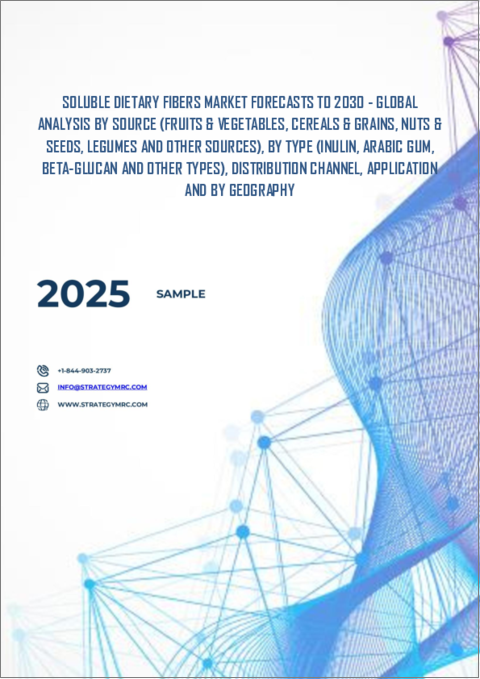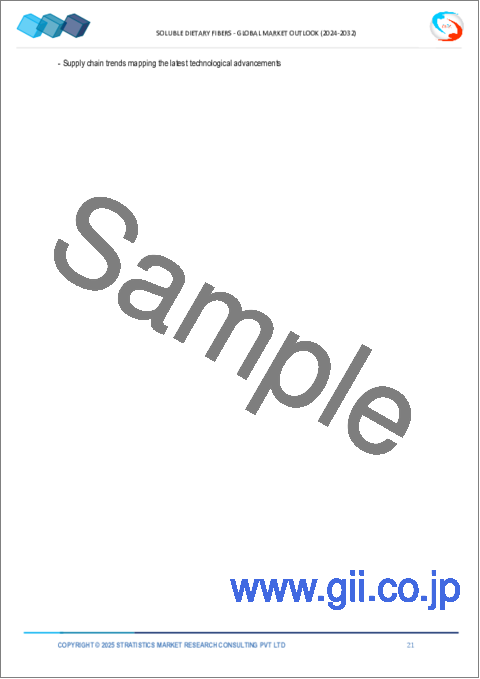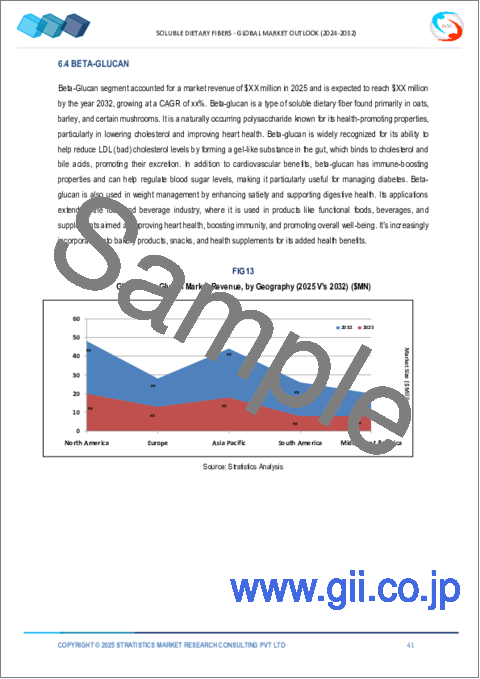|
|
市場調査レポート
商品コード
1438244
水溶性食物繊維市場の2030年までの予測:原料別、タイプ別、流通チャネル別、用途別、地域別の世界分析Soluble Dietary Fibers Market Forecasts to 2030 - Global Analysis By Source, By Type, Distribution Channel, Application and By Geography |
||||||
カスタマイズ可能
|
|||||||
| 水溶性食物繊維市場の2030年までの予測:原料別、タイプ別、流通チャネル別、用途別、地域別の世界分析 |
|
出版日: 2024年02月02日
発行: Stratistics Market Research Consulting
ページ情報: 英文 200+ Pages
納期: 2~3営業日
|
全表示
- 概要
- 図表
- 目次
Stratistics MRCによると、世界の水溶性食物繊維市場は2023年に39億米ドルを占め、予測期間中にCAGR 9.8%で成長し、2030年には76億米ドルに達すると予測されています。
水溶性食物繊維は、植物性食品に含まれる化合物で、水に溶けてゲル状の物質を形成します。水溶性食物繊維には、ペクチン、ガム、一部のヘミセルロースなどが含まれます。これらの食物繊維は、血糖値を調整したり、コレステロールを低下させたりする働きがあり、消化器系の健康に重要な役割を果たしています。一般的な摂取源としては、果物、野菜、オート麦、豆類などがあり、全体的な健康に貢献し、健康な胃腸システムをサポートします。
ミンテルが2020年9月に発表した「パテント・インサイト;飲食品中の食物繊維」と題する報告書によると、米国の消費者の86%が消化器系の緩和のために食物繊維の多い食品や飲料を試したことがあるか、試す用意があると回答しています。
機能性食品および飲料の人気の高まり
機能性食品や飲食品の人気の高まりは、水溶性食物繊維市場の主要な促進要因となっています。消費者がますます健康とウェルネスを優先するようになるにつれ、栄養面でのその他の特典を提供する製品に対する需要が高まっています。水溶性食物繊維は、消化器系の健康や健康全般に良い影響を与えることで知られ、機能性食品や飲食品に配合されつつあります。この動向は、メーカーが消費者の嗜好を満たし、製品イノベーションを推進し、健康志向の機能性食品・飲食品市場の拡大に資本投下する有利な機会をもたらします。
特定の水溶性食物繊維の高い生産コスト
特定の水溶性食物繊維の生産コストが高いことが、市場の大きな抑制要因となっています。抽出プロセス、原材料の調達、高度な製造技術などの要因により、製造コストが上昇する可能性があります。その結果、製品全体のコストが上昇し、製造業者と消費者の両方にとって値ごろ感が制限される可能性があります。生産コストの高騰に伴う経済的課題は、市場競争力と収益性を阻害する可能性があります。さらに、競争市場における価格圧力は、様々な食品への水溶性食物繊維の採用を制限する可能性があります。
健康意識の高まり
消費者の健康意識は高まっており、そのため栄養面でのメリットを提供する製品に対する需要が高まっています。水溶性食物繊維は、消化器系の健康、体重管理、コレステロール値に良い影響を与えることで知られており、この動向に合致しています。メーカーは、水溶性食物繊維の健康上の利点を宣伝することでこの機会を活用し、全人的な健康に対する消費者の関心の高まりに対応することができます。
限られた消費者の認識と誤解
限られた消費者の認識と誤解が、水溶性食物繊維市場の大きな阻害要因となっています。多くの消費者は水溶性食物繊維の健康上の利点や供給源に対する認識が不足しており、市場の成長を妨げています。水溶性食物繊維の役割、潜在的な副作用、または効果に関する誤解は、さらに採用への消極的な姿勢の一因となっています。
COVID-19の影響:
水溶性食物繊維市場は、COVID-19の大流行の中で課題と機会の両方を経験してきました。サプライ・チェーンと生産に混乱が見られた一方で、健康と免疫に対する消費者の関心の高まりが、水溶性食物繊維を含む機能性食品への需要を牽引しました。消費者の嗜好の変化に適応し、流通にオンライン・プラットフォームを活用しているメーカーは課題を克服しており、パンデミック後の時代における回復力と潜在的成長を示しています。
予測期間中、果物・野菜分野が最大となる見込み
果物・野菜分野は、これらの食品カテゴリーに関連する健康上の利点に対する消費者の意識の高まりにより、予測期間中最大になると予測されます。健康的なライフスタイルの採用の増加、天然および有機製品の重視、新鮮な青果物に対する需要の高まりが、このセグメントの優位性に寄与しています。消費者が栄養価の高い選択肢を優先していることから、果物・野菜部門は持続的な成長が見込まれ、市場全体で大きなシェアを占めています。
予測期間中にCAGRが最も高くなると予想されるオンラインストア部門
オンラインストア分野は予測期間中に有利な成長を遂げると予測されます。この背景には、オンラインショッピングに対する消費者の嗜好の高まり、利便性、幅広い商品ラインナップがあります。デジタル化、アクセスの容易さ、競合価格といった要因が、様々な分野におけるオンラインストアの急成長に寄与しています。eコマースが世界的に拡大し続ける中、オンラインストアの分野は他の流通チャネルを凌駕する大幅な成長が見込まれています。
最大のシェアを占める地域
北米は、健康志向の高まりと機能性食品素材に対する需要の急増に牽引され、水溶性食物繊維市場をリードする構えです。同地域は飲食品産業が確立されており、食の健康に対する消費者の意識が高いことも相まって、圧倒的な市場勢力として位置づけられています。製品イノベーションの増加と様々な食品に水溶性食物繊維を取り入れるという積極的なアプローチが、水溶性食物繊維分野の成長と進歩を促進する上で北米の優位性に寄与しています。
CAGRが最も高い地域:
アジア太平洋地域は、健康とウェルネスに対する意識の高まりと生活習慣病の有病率の上昇により、水溶性食物繊維市場の急成長が予想されます。食生活パターンの変化と機能性食品を求める中間層の増加が市場拡大に寄与しています。この地域の飲食品業界は、より健康的な選択肢を求める消費者の嗜好に対応することで、水溶性食物繊維の需要をさらに促進しており、アジア太平洋地域は繁栄する市場の主要プレーヤーとして位置づけられています。
無料カスタマイズサービス:
本レポートをご購読のお客様には、以下の無料カスタマイズオプションのいずれかをご利用いただけます:
- 企業プロファイル
- 追加市場プレーヤーの包括的プロファイリング(3社まで)
- 主要企業のSWOT分析(3社まで)
- 地域セグメンテーション
- 顧客の関心に応じた主要国の市場推計・予測・CAGR(注:フィージビリティチェックによる)
- 競合ベンチマーキング
- 製品ポートフォリオ、地理的プレゼンス、戦略的提携に基づく主要企業のベンチマーキング
目次
第1章 エグゼクティブサマリー
第2章 序文
- 概要
- ステークホルダー
- 調査範囲
- 調査手法
- データマイニング
- データ分析
- データ検証
- 調査アプローチ
- 調査ソース
- 1次調査ソース
- 2次調査ソース
- 前提条件
第3章 市場動向分析
- 促進要因
- 抑制要因
- 機会
- 脅威
- アプリケーション分析
- 新型コロナウイルス感染症(COVID-19)の影響
第4章 ポーターのファイブフォース分析
- 供給企業の交渉力
- 買い手の交渉力
- 代替品の脅威
- 新規参入業者の脅威
- 競争企業間の敵対関係
第5章 世界の水溶性食物繊維市場:原料別
- 果物と野菜
- 柑橘類
- りんご
- ベリー類
- その他の果物と野菜
- 穀類と穀物
- オーツ麦
- オオムギ
- サイリウム
- その他の穀類および穀物
- ナッツと種子
- マメ科植物
- その他の減量
第6章 世界の水溶性食物繊維市場:タイプ別
- イヌリン
- アラビアゴム
- ベータグルカン
- フラクトオリゴ糖(FOS)
- グアーガム
- ペクチン
- その他のタイプ
第7章 世界の水溶性食物繊維市場:流通チャネル別
- オンラインストア
- ハイパーマーケットとスーパーマーケット
- コンビニエンスストア
- 専門店
- その他の流通チャネル
第8章 世界の水溶性食物繊維市場:用途別
- 食べ物と飲み物
- 動物の飼料
- 医薬品
- 栄養補助食品
- パーソナルケアと化粧品
- その他の用途
第9章 世界の水溶性食物繊維市場:地域別
- 北米
- 米国
- カナダ
- メキシコ
- 欧州
- ドイツ
- 英国
- イタリア
- フランス
- スペイン
- その他欧州
- アジア太平洋地域
- 日本
- 中国
- インド
- オーストラリア
- ニュージーランド
- 韓国
- その他アジア太平洋地域
- 南米
- アルゼンチン
- ブラジル
- チリ
- その他南米
- 中東とアフリカ
- サウジアラビア
- アラブ首長国連邦
- カタール
- 南アフリカ
- その他中東とアフリカ
第10章 主な発展
- 契約、パートナーシップ、コラボレーション、合弁事業
- 買収と合併
- 新製品の発売
- 事業拡大
- その他の主要戦略
第11章 企業プロファイル
- Archer Daniels Midland Company
- Beneo GmbH
- Cargill, Incorporated
- Cosucra Groupe Warcoing SA
- DuPont de Nemours, Inc.
- Fibersol LLC
- Fiberstar, Inc.
- Grain Processing Corporation
- Ingredion Incorporated
- Kerry Group plc
- Lonza Group AG
- Nexira SAS
- Roquette Freres
- Sudzucker AG
- Taiyo International Inc.
- Tate & Lyle PLC
- Tereos S.A.
List of Tables
- Table 1 Global Soluble Dietary Fibers Market Outlook, By Region (2021-2030) ($MN)
- Table 2 Global Soluble Dietary Fibers Market Outlook, By Source (2021-2030) ($MN)
- Table 3 Global Soluble Dietary Fibers Market Outlook, By Fruits & Vegetables (2021-2030) ($MN)
- Table 4 Global Soluble Dietary Fibers Market Outlook, By Citrus fruits (2021-2030) ($MN)
- Table 5 Global Soluble Dietary Fibers Market Outlook, By Apples (2021-2030) ($MN)
- Table 6 Global Soluble Dietary Fibers Market Outlook, By Berries (2021-2030) ($MN)
- Table 7 Global Soluble Dietary Fibers Market Outlook, By Other Fruits & Vegetables (2021-2030) ($MN)
- Table 8 Global Soluble Dietary Fibers Market Outlook, By Cereals & Grains (2021-2030) ($MN)
- Table 9 Global Soluble Dietary Fibers Market Outlook, By Oats (2021-2030) ($MN)
- Table 10 Global Soluble Dietary Fibers Market Outlook, By Barley (2021-2030) ($MN)
- Table 11 Global Soluble Dietary Fibers Market Outlook, By Psyllium (2021-2030) ($MN)
- Table 12 Global Soluble Dietary Fibers Market Outlook, By Other Cereals & Grains (2021-2030) ($MN)
- Table 13 Global Soluble Dietary Fibers Market Outlook, By Nuts & Seeds (2021-2030) ($MN)
- Table 14 Global Soluble Dietary Fibers Market Outlook, By Legumes (2021-2030) ($MN)
- Table 15 Global Soluble Dietary Fibers Market Outlook, By Other Sources (2021-2030) ($MN)
- Table 16 Global Soluble Dietary Fibers Market Outlook, By Type (2021-2030) ($MN)
- Table 17 Global Soluble Dietary Fibers Market Outlook, By Inulin (2021-2030) ($MN)
- Table 18 Global Soluble Dietary Fibers Market Outlook, By Arabic Gum (2021-2030) ($MN)
- Table 19 Global Soluble Dietary Fibers Market Outlook, By Beta-Glucan (2021-2030) ($MN)
- Table 20 Global Soluble Dietary Fibers Market Outlook, By Fructooligosaccharides (FOS) (2021-2030) ($MN)
- Table 21 Global Soluble Dietary Fibers Market Outlook, By Guar Gum (2021-2030) ($MN)
- Table 22 Global Soluble Dietary Fibers Market Outlook, By Pectin (2021-2030) ($MN)
- Table 23 Global Soluble Dietary Fibers Market Outlook, By Other Types (2021-2030) ($MN)
- Table 24 Global Soluble Dietary Fibers Market Outlook, By Distribution Channel (2021-2030) ($MN)
- Table 25 Global Soluble Dietary Fibers Market Outlook, By Online Stores (2021-2030) ($MN)
- Table 26 Global Soluble Dietary Fibers Market Outlook, By Hypermarkets & Supermarkets (2021-2030) ($MN)
- Table 27 Global Soluble Dietary Fibers Market Outlook, By Convenience Stores (2021-2030) ($MN)
- Table 28 Global Soluble Dietary Fibers Market Outlook, By Specialty Stores (2021-2030) ($MN)
- Table 29 Global Soluble Dietary Fibers Market Outlook, By Other Distribution Channels (2021-2030) ($MN)
- Table 30 Global Soluble Dietary Fibers Market Outlook, By Application (2021-2030) ($MN)
- Table 31 Global Soluble Dietary Fibers Market Outlook, By Food & Beverages (2021-2030) ($MN)
- Table 32 Global Soluble Dietary Fibers Market Outlook, By Animal Feed (2021-2030) ($MN)
- Table 33 Global Soluble Dietary Fibers Market Outlook, By Pharmaceuticals (2021-2030) ($MN)
- Table 34 Global Soluble Dietary Fibers Market Outlook, By Dietary Supplements (2021-2030) ($MN)
- Table 35 Global Soluble Dietary Fibers Market Outlook, By Personal Care & Cosmetics (2021-2030) ($MN)
- Table 36 Global Soluble Dietary Fibers Market Outlook, By Other Applications (2021-2030) ($MN)
Note: Tables for North America, Europe, APAC, South America, and Middle East & Africa Regions are also represented in the same manner as above.
According to Stratistics MRC, the Global Soluble Dietary Fibers Market is accounted for $3.9 billion in 2023 and is expected to reach $7.6 billion by 2030 growing at a CAGR of 9.8% during the forecast period. Soluble dietary fibers are compounds found in plant-based foods that dissolve in water, forming a gel-like substance. They include pectins, gums, and some hemicelluloses. These fibers play a crucial role in digestive health, as they can help regulate blood sugar levels and lower cholesterol. Common sources include fruits, vegetables, oats, and legumes, contributing to overall well-being and supporting a healthy gastrointestinal system.
According to a report published in September 2020 by Mintel titled "Patent Insights; dietary fibers in food and drinks," 86% of US consumers have either tried or would be prepared to try high-fiber foods and beverages for digestive relief.
Market Dynamics:
Driver:
Growing popularity of functional foods and beverages
The growing popularity of functional foods and beverages serves as a key driver in the soluble dietary fiber market. As consumers increasingly prioritize health and wellness, there is a rising demand for products that offer additional nutritional benefits. Soluble dietary fibers, known for their positive impact on digestive health and overall well-being, are being incorporated into functional foods and beverages. This trend presents a lucrative opportunity for manufacturers to meet consumer preferences, drive product innovation, and capitalize on the expanding market for health-oriented and functional food and beverage products.
Restraint:
Higher production costs of certain soluble dietary fibers
The higher production costs of certain soluble dietary fibers constitute a significant restraint in the market. Production expenses can be elevated due to factors such as extraction processes, sourcing raw materials, and sophisticated manufacturing techniques. This results in increased overall product costs, potentially limiting affordability for both manufacturers and consumers. The economic challenges associated with high production costs may hinder market competitiveness and profitability. Additionally, pricing pressures in a competitive market may limit the adoption of soluble dietary fibers in various food products.
Opportunity:
Growing health awareness
Consumers are becoming more health-conscious, and due to this, there is an increasing demand for products that offer nutritional benefits. Soluble dietary fibers, known for their positive impact on digestive health, weight management, and cholesterol levels, align with this trend. Manufacturers can capitalize on this opportunity by promoting the health benefits of soluble dietary fiber, thereby catering to the rising consumer interest in holistic well-being.
Threat:
Limited consumer awareness and misconceptions
Limited consumer awareness and misconceptions pose significant restraints in the soluble dietary fiber market. Many consumers lack awareness of the health benefits and sources of soluble dietary fibers, hindering market growth. Misconceptions about their role, potential side effects, or effectiveness further contribute to reluctance toward adoption.
Covid-19 Impact:
The soluble dietary fiber market has experienced both challenges and opportunities amid the COVID-19 pandemic. While disruptions in supply chains and production were observed, increased consumer focus on health and immunity has driven demand for functional foods, including those containing soluble dietary fibers. Manufacturers adapting to changing consumer preferences and leveraging online platforms for distribution have navigated the challenges, indicating resilience and potential growth in the post-pandemic era.
The fruits & vegetables segment is expected to be the largest during the forecast period
The fruits and vegetables segment is anticipated to be the largest during the forecast period due to growing consumer awareness of the health benefits associated with these food categories. Increasing adoption of a healthy lifestyle, an emphasis on natural and organic products, and rising demand for fresh produce contribute to the dominance of this segment. With consumers prioritizing nutritious options, the fruits and vegetables segment is expected to experience sustained growth, reflecting a significant share in the overall market.
The online stores segment is expected to have the highest CAGR during the forecast period
The online stores segment is projected to achieve lucrative growth during the forecast period. This is attributed to the increasing consumer preference for online shopping, convenience, and a broader product range. Factors such as digitalization, easy accessibility, and competitive pricing contribute to the rapid growth of online stores in various sectors. As e-commerce continues to expand globally, the online store segment is anticipated to experience substantial growth, outpacing other distribution channels.
Region with largest share:
North America is poised to lead the soluble dietary fiber market, driven by a heightened focus on health-conscious lifestyles and a surge in demand for functional food ingredients. The region's well-established food and beverage industry, coupled with robust consumer awareness of dietary health, positions it as a dominant market force. Increasing product innovations and a proactive approach toward incorporating soluble dietary fibers in various food products contribute to North America's dominance in fostering growth and advancements in the soluble dietary fibers sector.
Region with highest CAGR:
The Asia Pacific region is anticipated to witness rapid growth in the soluble dietary fiber market due to increasing awareness of health and wellness, coupled with a rising prevalence of lifestyle-related diseases. Changing dietary patterns and a growing middle-class population seeking functional food options contribute to market expansion. The region's food and beverage industry's responsiveness to consumer preferences for healthier choices further propels the demand for soluble dietary fibers, positioning the Asia Pacific as a key player in the flourishing market.
Key players in the market
Some of the key players in soluble dietary fibers market include Archer Daniels Midland Company, Beneo GmbH, Cargill, Incorporated, Cosucra Groupe Warcoing SA, DuPont de Nemours, Inc., Fibersol LLC, Fiberstar, Inc., Grain Processing Corporation, Ingredion Incorporated, Kerry Group plc, Lonza Group AG, Nexira SAS, Roquette Freres, Sudzucker AG, Taiyo International Inc., Tate & Lyle PLC and Tereos S.A.
Key Developments:
In October 2023, Tate & Lyle PLC (Tate & Lyle), a world leader in ingredient solutions for healthier food and beverages, announces a major investment programme in its corn wet mill in Boleraz, Slovakia, to establish new capacity for its leading non-GMO PROMITOR ® Soluble Fibres. The production of fibres during the first phase of the programme will start in mid-2024, representing a €25 million investment. This programme is expected to significantly increase Tate & Lyle's fibre capacity to serve both its European and global customer base.
In July 2021, Cargill is investing $45 million to add soluble fibers to its European portfolio of starches, sweeteners and texturizers. While the move marks the company's first entry into the European soluble fiber market, Cargill is already a significant player in the sugar-reduction space, with a full line of sweeteners - ranging from full- to no-calorie. The new soluble fibers round out that portfolio, enabling the company to offer customers complete sugar-reduction solutions.
Sources Covered:
- Fruits & Vegetables
- Cereals & Grains
- Nuts & Seeds
- Legumes
- Other Sources
Types Covered:
- Inulin
- Arabic Gum
- Beta-Glucan
- Fructooligosaccharides (FOS)
- Guar Gum
- Pectin
- Other Types
Distribution Channels Covered:
- Online Stores
- Hypermarkets & Supermarkets
- Convenience Stores
- Specialty Stores
- Other Distribution Channels
Applications Covered:
- Food & Beverages
- Animal Feed
- Pharmaceuticals
- Dietary Supplements
- Personal Care & Cosmetics
- Other Applications
Regions Covered:
- North America
- US
- Canada
- Mexico
- Europe
- Germany
- UK
- Italy
- France
- Spain
- Rest of Europe
- Asia Pacific
- Japan
- China
- India
- Australia
- New Zealand
- South Korea
- Rest of Asia Pacific
- South America
- Argentina
- Brazil
- Chile
- Rest of South America
- Middle East & Africa
- Saudi Arabia
- UAE
- Qatar
- South Africa
- Rest of Middle East & Africa
What our report offers:
- Market share assessments for the regional and country-level segments
- Strategic recommendations for the new entrants
- Covers Market data for the years 2021, 2022, 2023, 2026, and 2030
- Market Trends (Drivers, Constraints, Opportunities, Threats, Challenges, Investment Opportunities, and recommendations)
- Strategic recommendations in key business segments based on the market estimations
- Competitive landscaping mapping the key common trends
- Company profiling with detailed strategies, financials, and recent developments
- Supply chain trends mapping the latest technological advancements
Free Customization Offerings:
All the customers of this report will be entitled to receive one of the following free customization options:
- Company Profiling
- Comprehensive profiling of additional market players (up to 3)
- SWOT Analysis of key players (up to 3)
- Regional Segmentation
- Market estimations, Forecasts and CAGR of any prominent country as per the client's interest (Note: Depends on feasibility check)
- Competitive Benchmarking
- Benchmarking of key players based on product portfolio, geographical presence, and strategic alliances
Table of Contents
1 Executive Summary
2 Preface
- 2.1 Abstract
- 2.2 Stake Holders
- 2.3 Research Scope
- 2.4 Research Methodology
- 2.4.1 Data Mining
- 2.4.2 Data Analysis
- 2.4.3 Data Validation
- 2.4.4 Research Approach
- 2.5 Research Sources
- 2.5.1 Primary Research Sources
- 2.5.2 Secondary Research Sources
- 2.5.3 Assumptions
3 Market Trend Analysis
- 3.1 Introduction
- 3.2 Drivers
- 3.3 Restraints
- 3.4 Opportunities
- 3.5 Threats
- 3.6 Application Analysis
- 3.7 Impact of Covid-19
4 Porters Five Force Analysis
- 4.1 Bargaining power of suppliers
- 4.2 Bargaining power of buyers
- 4.3 Threat of substitutes
- 4.4 Threat of new entrants
- 4.5 Competitive rivalry
5 Global Soluble Dietary Fibers Market, By Source
- 5.1 Introduction
- 5.2 Fruits & Vegetables
- 5.2.1 Citrus fruits
- 5.2.2 Apples
- 5.2.3 Berries
- 5.2.4 Other Fruits & Vegetables
- 5.3 Cereals & Grains
- 5.3.1 Oats
- 5.3.2 Barley
- 5.3.3 Psyllium
- 5.3.4 Other Cereals & Grains
- 5.4 Nuts & Seeds
- 5.5 Legumes
- 5.6 Other Sources
6 Global Soluble Dietary Fibers Market, By Type
- 6.1 Introduction
- 6.2 Inulin
- 6.3 Arabic Gum
- 6.4 Beta-Glucan
- 6.5 Fructooligosaccharides (FOS)
- 6.6 Guar Gum
- 6.7 Pectin
- 6.8 Other Types
7 Global Soluble Dietary Fibers Market, By Distribution Channel
- 7.1 Introduction
- 7.2 Online Stores
- 7.3 Hypermarkets & Supermarkets
- 7.4 Convenience Stores
- 7.5 Specialty Stores
- 7.6 Other Distribution Channels
8 Global Soluble Dietary Fibers Market, By Application
- 8.1 Introduction
- 8.2 Food & Beverages
- 8.3 Animal Feed
- 8.4 Pharmaceuticals
- 8.5 Dietary Supplements
- 8.6 Personal Care & Cosmetics
- 8.7 Other Applications
9 Global Soluble Dietary Fibers Market, By Geography
- 9.1 Introduction
- 9.2 North America
- 9.2.1 US
- 9.2.2 Canada
- 9.2.3 Mexico
- 9.3 Europe
- 9.3.1 Germany
- 9.3.2 UK
- 9.3.3 Italy
- 9.3.4 France
- 9.3.5 Spain
- 9.3.6 Rest of Europe
- 9.4 Asia Pacific
- 9.4.1 Japan
- 9.4.2 China
- 9.4.3 India
- 9.4.4 Australia
- 9.4.5 New Zealand
- 9.4.6 South Korea
- 9.4.7 Rest of Asia Pacific
- 9.5 South America
- 9.5.1 Argentina
- 9.5.2 Brazil
- 9.5.3 Chile
- 9.5.4 Rest of South America
- 9.6 Middle East & Africa
- 9.6.1 Saudi Arabia
- 9.6.2 UAE
- 9.6.3 Qatar
- 9.6.4 South Africa
- 9.6.5 Rest of Middle East & Africa
10 Key Developments
- 10.1 Agreements, Partnerships, Collaborations and Joint Ventures
- 10.2 Acquisitions & Mergers
- 10.3 New Product Launch
- 10.4 Expansions
- 10.5 Other Key Strategies
11 Company Profiling
- 11.1 Archer Daniels Midland Company
- 11.2 Beneo GmbH
- 11.3 Cargill, Incorporated
- 11.4 Cosucra Groupe Warcoing SA
- 11.5 DuPont de Nemours, Inc.
- 11.6 Fibersol LLC
- 11.7 Fiberstar, Inc.
- 11.8 Grain Processing Corporation
- 11.9 Ingredion Incorporated
- 11.10 Kerry Group plc
- 11.11 Lonza Group AG
- 11.12 Nexira SAS
- 11.13 Roquette Freres
- 11.14 Sudzucker AG
- 11.15 Taiyo International Inc.
- 11.16 Tate & Lyle PLC
- 11.17 Tereos S.A.





